-
Car Reviews
- Car News
-
Car Comparisons
Latest comparisons
- Chasing Deals
The sportiest ID.Buzz could’ve turned out unbearably firm and a step too far for this iconic-looking electric van. But the GTX is clearly the best people-carrying Buzz so far
From the moment we saw the Volkswagen ID.Buzz in the flesh, endorphins flowed. It’s such a cool thing – the sort of vehicle that transcends class divides and literally stops traffic with its retro-modern Kombi character.
And once you start chatting to the public (which is inevitable!), they don’t seem quite so put off by its pricing, given that so many of them have already paid 75-odd grand (or more) for an agricultural dual-cab ute.
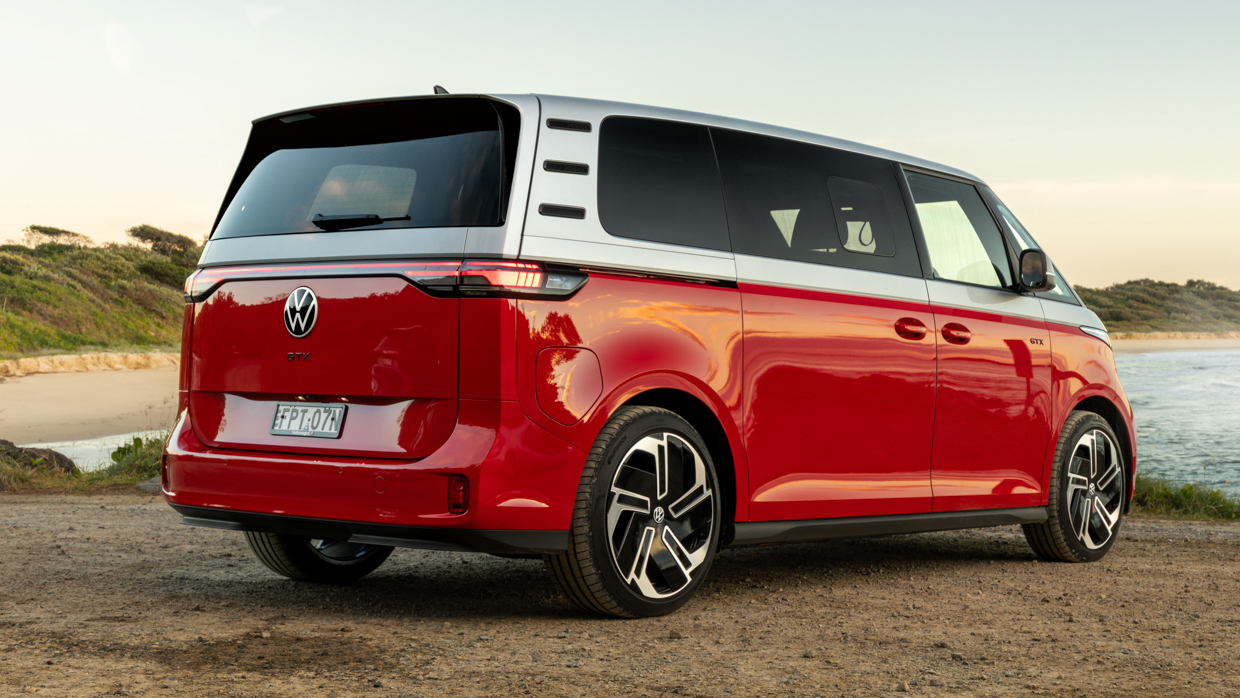
Considering that link in desirability between an ID.Buzz and an ‘aspirational’ dual-cab, perhaps the regular people-carrying VW van’s almost nauseatingly reactive ride quality wouldn’t be such as issue – almost all 4WD utes ride terribly so nothing lost there!
But when other MEB-platformed Volkswagen Group EVs do such a good job at absorbing what’s underneath – particularly something like a base Skoda Enyaq, even riding on 21s – it’s been a considerable disappointment for us that by far the best-driving ID.Buzz so far has been the humble three-seat Cargo (on its chubby 18-inch tyres), not the sexy but abrasively uncomfortable five-seat Pro wearing optional 21s.
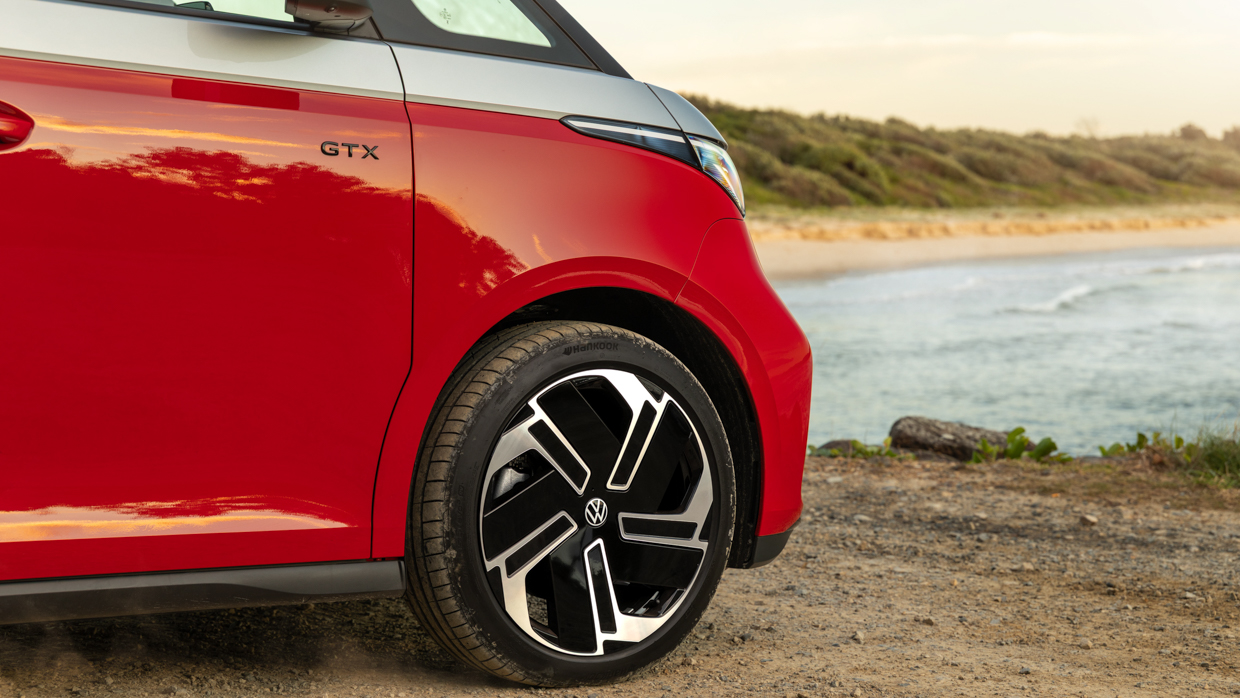
All of which engendered little hope for this comparatively warm ID.Buzz GTX. It’s faster and sexier, sure, but would ‘sports’ suspension make the GTX even worse to ride in than the regular rear-drive Buzz Pro? Would it regurgitate lunch’s burger-with-the-works and thickshake chaser faster than you could say “someone pass me a bucket”?
Thankfully, no. While the Buzz GTX is far from plush-riding and remains curiously bereft of the adaptive damping that partly quells the ride of the ID.4/5 GTXs, this sports-flavoured people mover is definitely a better bus.
Apparently the ‘sports’ description means higher-quality dampers and other suspension components, not stiffening it to buggery, and as a result, the GTX feels more sophisticated and more dynamically cohesive on all surfaces.
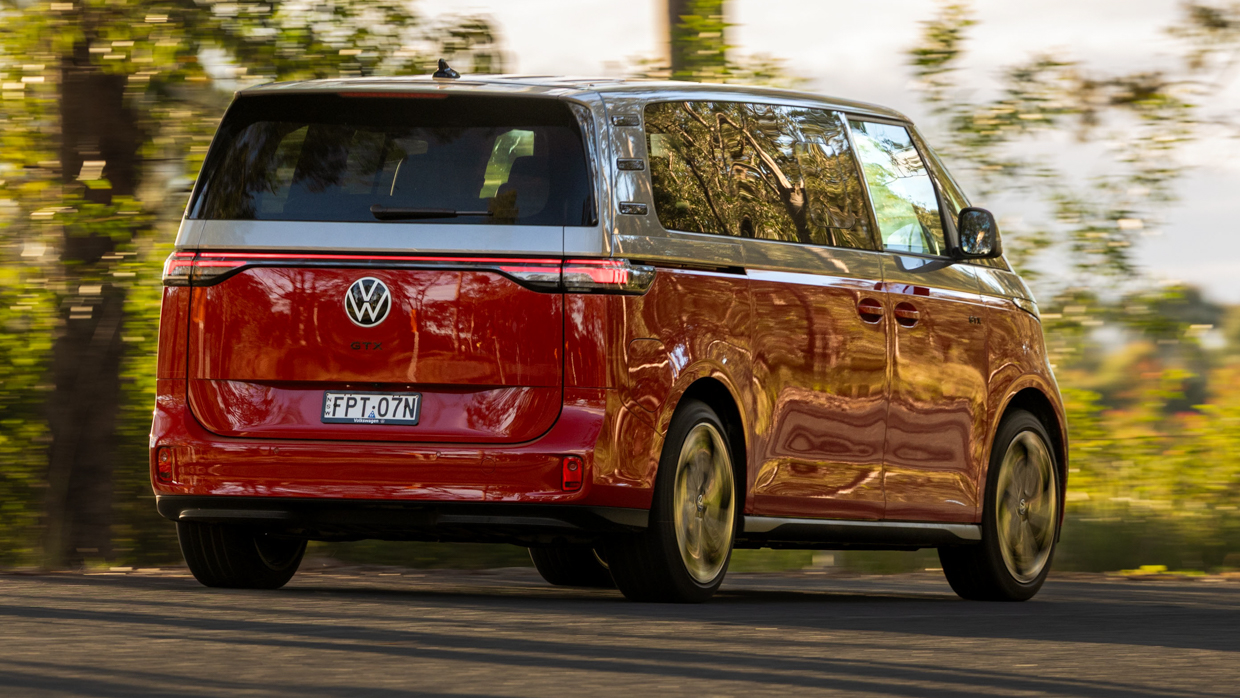
Gone is much of the vertical motion that disturbs your innards in the regular Buzz Pro, though the GTX’s ride is still quite knobbly and lumpy, in part because it’s riding on its own ‘Townsville’ 21-inch alloys with 235/45R21 front and 265/40R21 rear Hankook Ventus S1 Evo 3 tyres.
And thanks to the overall chassis tuning from Volkswagen’s performance division – the same engineers that tuned the ride/handling blend of the Mk8.5 Golf GTI and R – the Buzz GTX also steers more consistently, with better feel at straight ahead and a more natural progression when turning in than the regular Buzz Pro, especially when wearing huge 21s.
To the benefit of all this, the GTX is a long-wheelbase seven-seater, meaning more time between when each wheel hits a bump.
Yet such is the delightful delivery of power – 545Nm going to the rear wheels, 134Nm to the front pair – that as long as you have the GTX’s nose pinned and pointing where you want to go, stomping the right pedal demonstrates excellent poise, precision and power-down out of corners, with a smidge of oversteer adjustment.
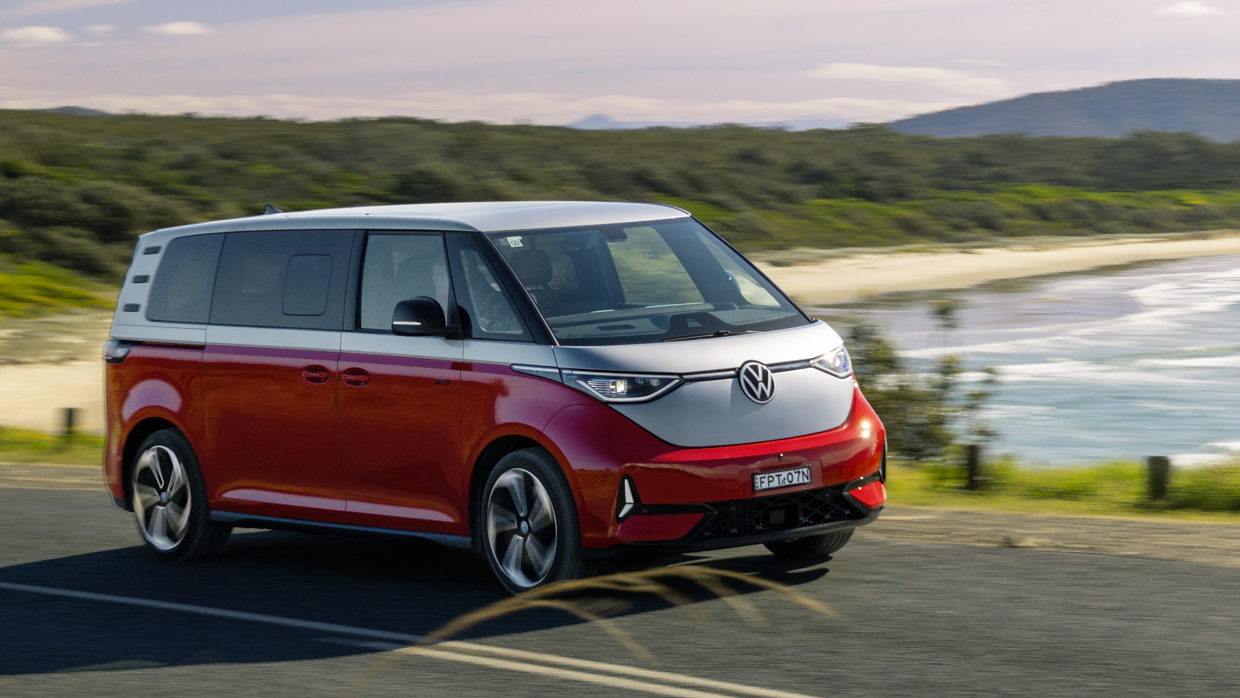
Acceleration is strong, too – the GTX’s 250kW maximum, plus additional torque and traction resulting in a 6.4sec to 100km/h claim (1.5sec less than the LWB Pro).
There’s an effortless smoothness and urgency to the way the Buzz GTX performs, meaning you rarely think about it weighing 2771kg. Only when pushing hard into harpins does the nose run wide … at which point you’ll wish that the GTX’s regenerative braking was more insistent on its solitary setting.
As for range, the GTX’s 450km WLTP distance is near-identical to the LWB Pro’s 452km.
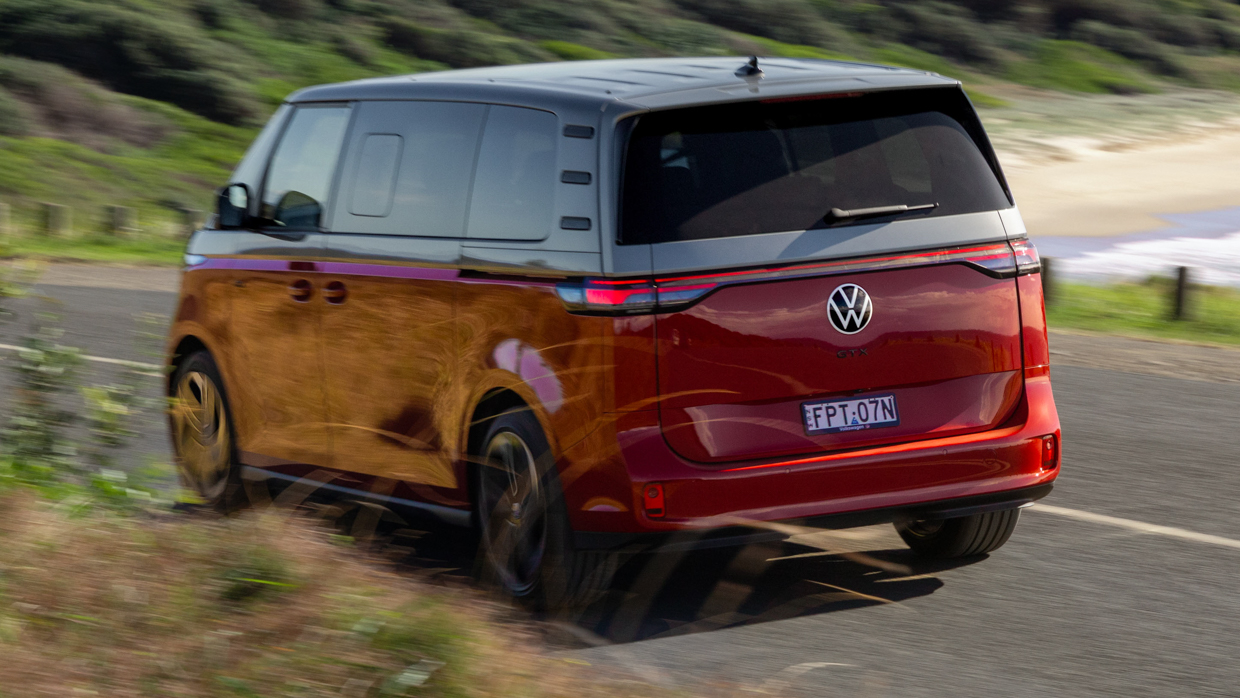
Punted enthusiastically during the Australian launch on roads around Crescent Head on the NSW mid-north coast, the GTX averaged between 22.0 and 23.3kWh/100km, meaning a hard-driven real-world range of roughly 369 to 391km. That bodes well for getting close to the 450km claim (or better) when driven normally around town.
Unlike the regular Buzz variants, which took over two years to arrive here, the GTX has only been on sale in Europe since last August, so it’s still relatively fresh.
The benefit of Volkswagen Oz waiting until 2025 for its entire Buzz line-up to reach customers is that they all get the latest software, including wireless Apple CarPlay/Android Auto – as featured here in this GTX, along with a rather pleasant 13-speaker Harman Kardon stereo with subwoofer.
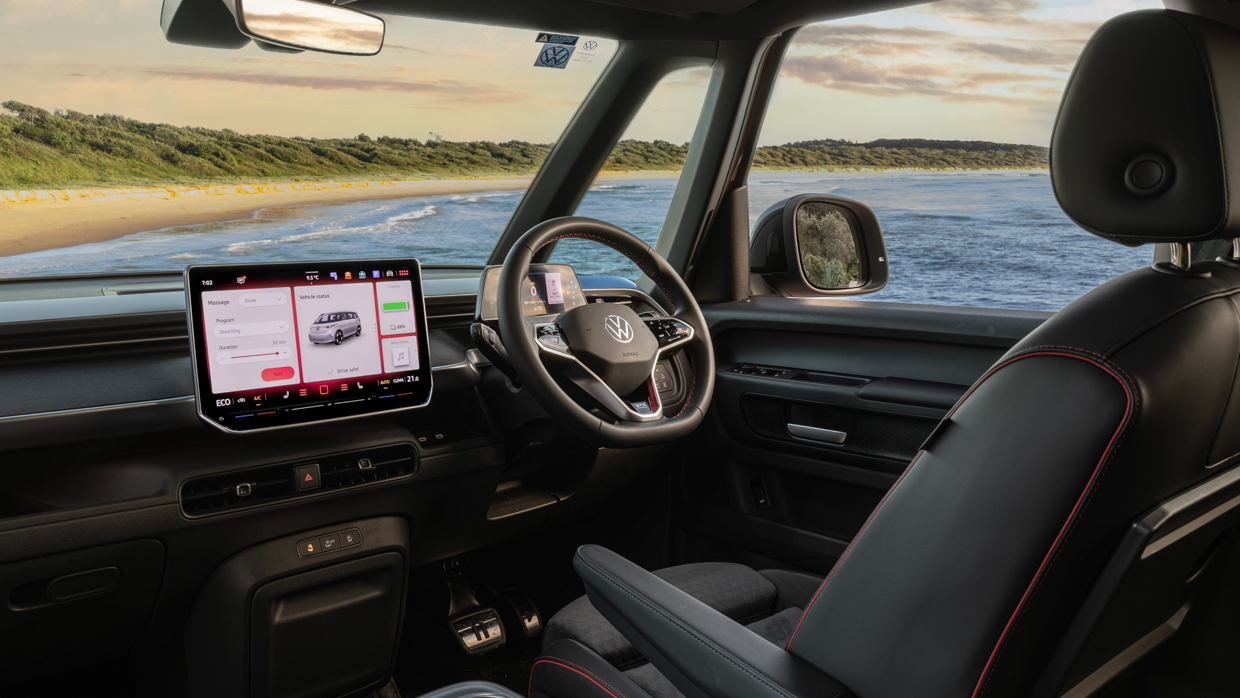
The GTX also introduces several styling changes, including the aforementioned 21-inch wheels as well as small, boomerang-shaped LED running lights in the lower front bumper, and unique metallic Mono Silver colouring for its upper two-tone, as well as a hero Cherry Red hue.
As with the Pro, adding two-tone costs $4090 extra, yet it appears the majority of customers are going for it globally across the Buzz range.
Lighting is ‘IQ Light’ LED Matrix up front with a full-width light bar, a design mirrored in red across the tailgate, combined with classy sequential rear indicators. There’s also a panoramic glass roof with ‘smart glass’ (it turns opaque when you ‘close’ it), and an easy open/close function for the electric sliding side doors and the rear tailgate.
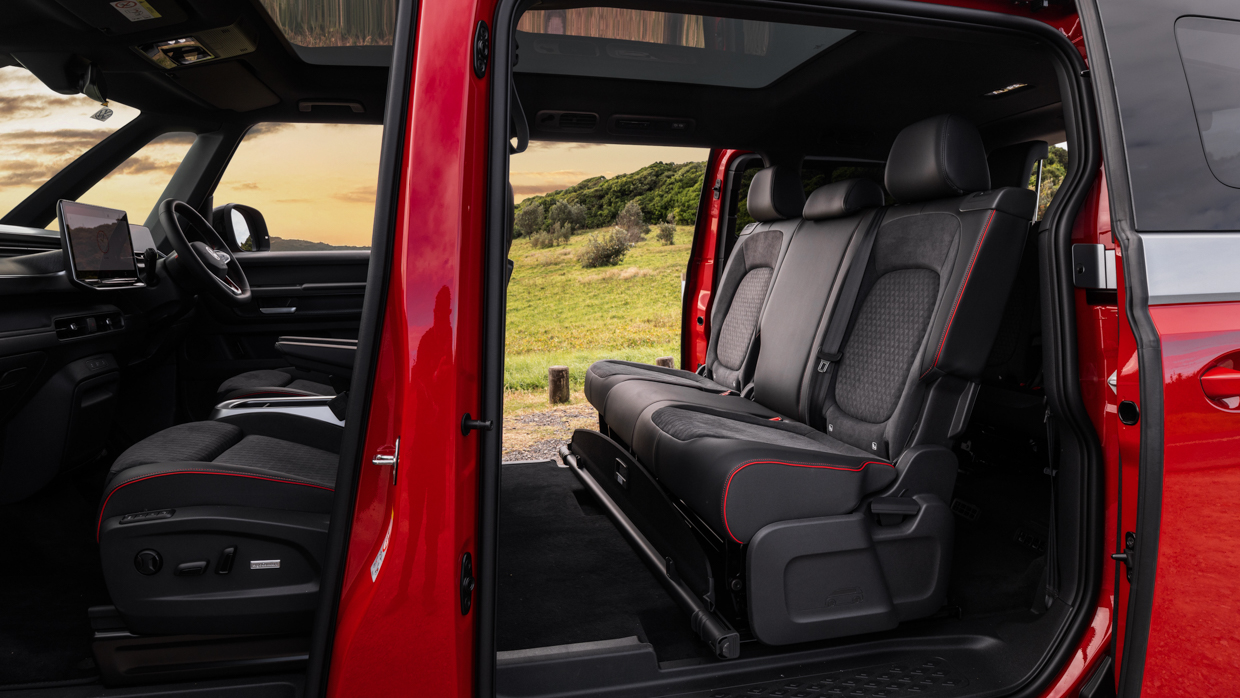
Inside, the performance-flavoured GTX opts for much darker colouring than the light and fresh, zen-like wellness of the regular Buzz Pro (particularly with the Seaqual or ArtVelours trim options).
The GTX gets black headlining and black ArtVelours microfleece seat fabric with red stitching, as well as a sports steering wheel with red baseball stitching, a head-up display and 30-colour ambient lighting.
Highlighting the GTX’s relative equipment value is the fact that it contains every piece of optional kit for LWB Pro as standard, but costs only $5330 more.
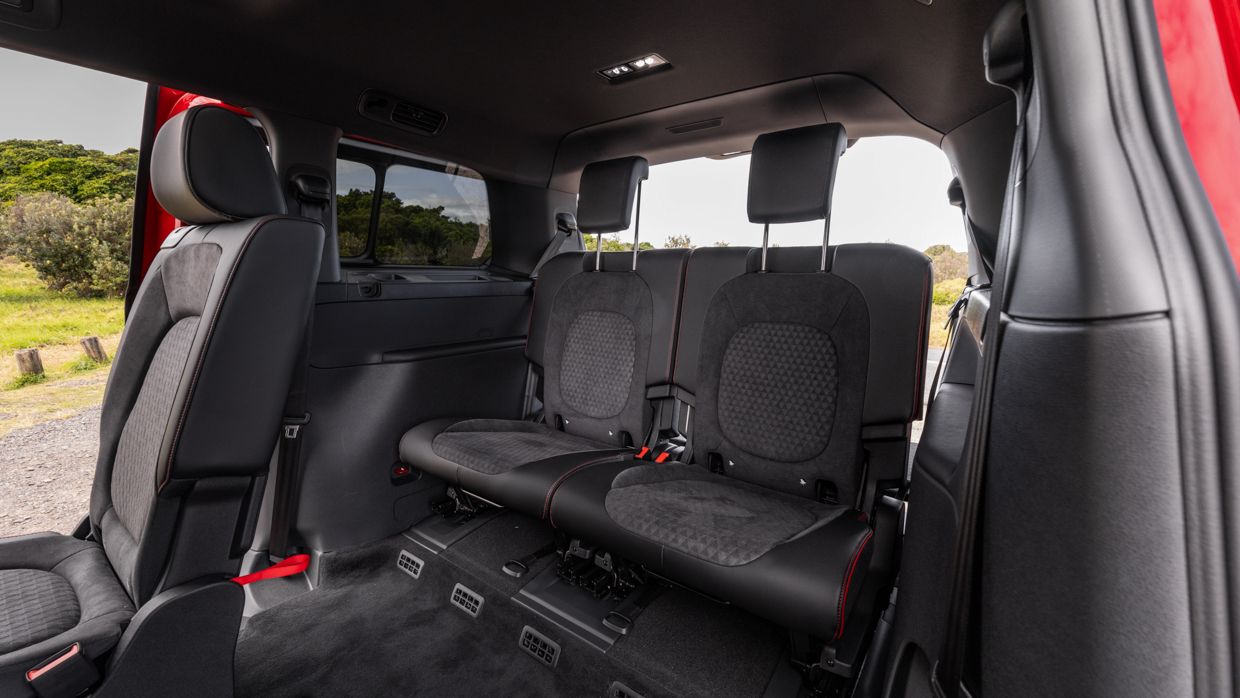
If you can see five grand’s worth in the GTX’s unique offerings – rear-biased AWD, 40kW more power, 1.5sec faster to 100km/h, a superior sports suspension tune and exclusive styling/design elements – then there really is value in this flagship electric seven-seater, despite its $109,990 base price.
Compare Buzz GTX pricing to other electric seven seaters, though, and it starts to look a lot less intimidating – especially if you’re an asset-rich Baby Boomer who bought real estate before the mid-90s.
All-wheel-drive versions of the Kia EV9 cost $107-121K, Zeekr’s 009 asks for $135-139K while sister brand Volvo’s brand new EX90 electric seven-seat SUV commands $125-135K before options – making the everyperson’s ID.Buzz GTX almost seem like good buying!
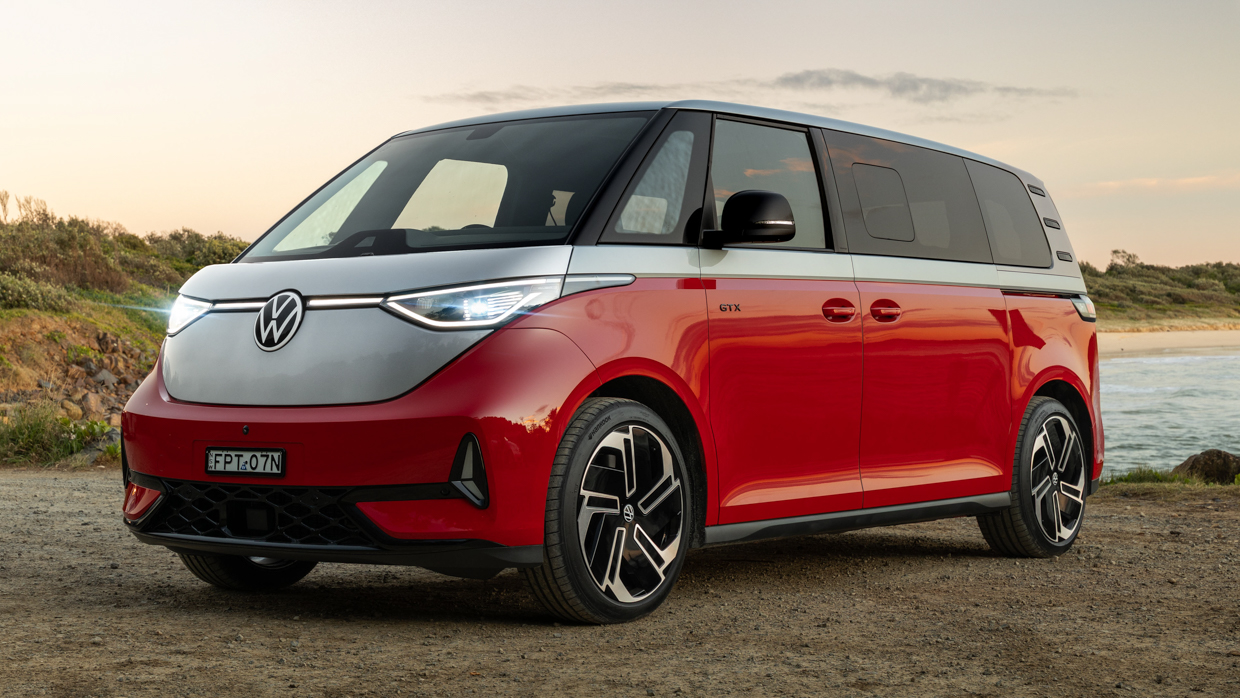
Options are limited to paint – metallic paint ($1890), pearl-effect paint ($1890) or two-tone ($4090) – plus 21-inch black alloy wheels ($380), though GTX colours are minimal (white, red, metallic silver, pearl black, metallic dark blue, and red/silver two-tone).
Servicing is pretty affordable, capped at $687 for every 24 month/30,000km interval, with servicing plans covering six years ($1450), eight years ($1850) or 10 years ($2250).
Given all that, plus the huge percentage take-up of performance Golf variants in Australia (the GTI and R make up half of total Golf volume, split evenly), Volkswagen expects the GTX to account for at least 20 percent of total Australian ID.Buzz sales – believed to be the highest percentage split of any global market.
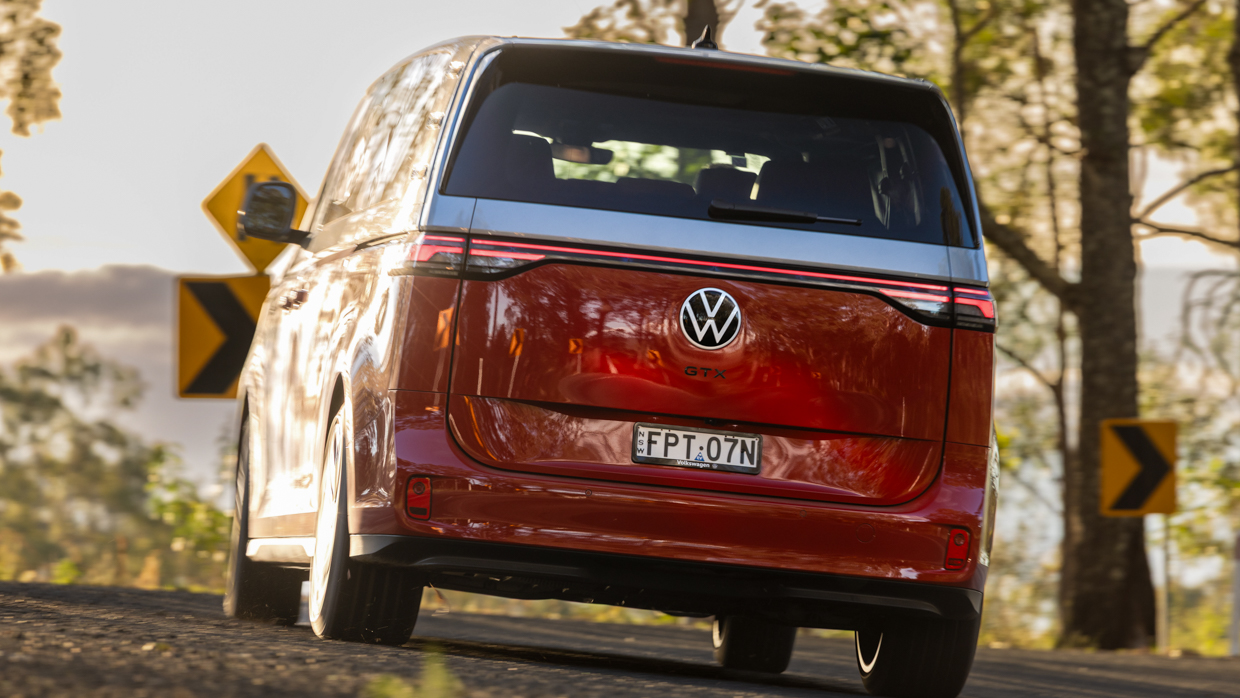
We do love our performance variants, even though the places to enjoy them are limited, and with this GTX, you’re also buying the fastest, sexiest and best-driving of all the ID.Buzz people-carrying versions.
So if your novated leasing options, or your own personal finances, can stomach the asking price, then there’s plenty of Volkswagen EV here you’ll likely grow to love.
Key specs (as tested)
About Chasing cars
Chasing Cars reviews are 100% independent.
Because we are powered by Budget Direct Insurance, we don’t receive advertising or sales revenue from car manufacturers.
We’re truly independent – giving you Australia’s best car reviews.
The estimate provided does not take into account your personal circumstances but is intended to give a general indication of the cost of insurance, in order to obtain a complete quote, please visit www.budgetdirect.com.au. Estimate includes 15%^ online discount.
^Conditions Apply
Budget Direct Insurance arranged by Auto & General Services Pty Ltd ACN 003 617 909(AGS) AFSL 241 411, for and on behalf of the insurer, Auto & General Insurance Company Limited(ABN 42 111 586 353, AFSL 285 571).Because we don’t know your financial needs, we can’t advise you if this insurance will suit you. You should consider your needs and the Product Disclosure Statement before making a decision to buy insurance. Terms and conditions apply.
Indicative quote based on assumptions including postcode , 40 year old male with no offences, licence suspensions or claims in the last 5 years, a NCD Rating 1 and no younger drivers listed. White car, driven up to 10,000kms a year, unfinanced, with no modifications, factory options and/or non-standard accessories, private use only and garaged at night.
^Online Discounts Terms & Conditions
1. Discounts apply to the premium paid for a new Budget Direct Gold Comprehensive Car Insurance, Third Party Property Only or Third Party Property, Fire & Theft Insurance policy initiated online on or after 29 March 2017. Discounts do not apply to optional Roadside Assistance.
2. Discounts do not apply to any renewal offer of insurance.
3. Discounts only apply to the insurance portion of the premium. Discounts are applied before government charges, taxes, levies and fees, including instalment processing fees (as applicable). The full extent of discounts may therefore be impacted.
4. We reserve the right to change the offer without notice.